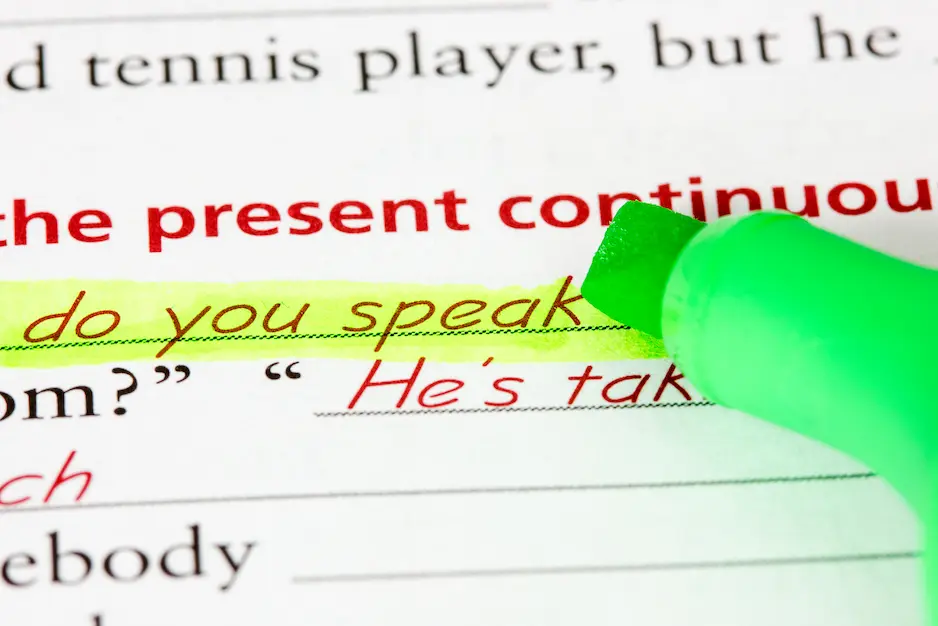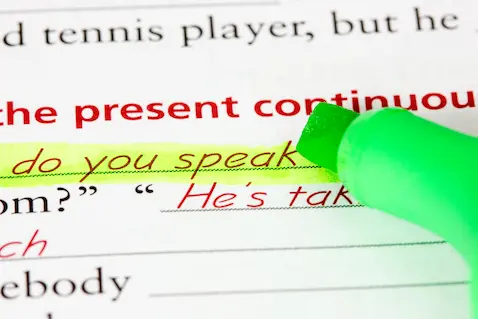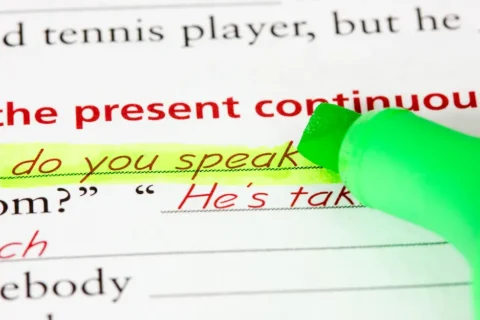Should grammar be taught implicitly – in context and through communication – or explicitly, with rules-based lessons? Or is a combination of the two the most effective approach?
This question has been central to English language teaching for decades. Based on both classroom experience and research, the most effective approach usually combines the two – depending on your learners, the grammar point, and the teaching context.
Why Grammar Matters
Grammar gives students the tools to understand how a language works. Teaching it effectively helps learners communicate more accurately and confidently. But how grammar is taught – explicitly or implicitly – has long been debated.
Explicit teaching focuses on learning the rules and structures of a language, often taught in isolation from communication. Implicit teaching helps students “pick up” grammar through meaningful communication, often without overt focus on rules.
Research supports this view. A 2018 study presented at the Asian Conference on Education & International Development concluded that both explicit and implicit grammar teaching can be effective, and the most successful approach depends on factors such as learners’ proficiency, motivation, and the specific grammar point being taught.
Similarly, Rod Ellis (2006) argued that a “focus on form” – drawing learners’ attention to grammatical features in meaningful communication – effectively combines the strengths of both explicit and implicit approaches. His review of research and classroom practice suggests this balanced approach usually gets better long-term results than sticking to just one method.
A comprehensive review of research by Norris & Ortega (2000) also found that explicit instruction tends to produce larger immediate gains, while implicit instruction supports longer-term retention and fluency when reinforced through practice.
Stephen Krashen’s Monitor Model (1982) also backs the idea that we learn best through meaningful input, but knowing the rules can still help learners check and improve what they say.
Advantages and Disadvantages of Each Approach
| Implicit Instruction | Explicit Instruction | |
|---|---|---|
| Advantages | Natural and communicative; less intimidating; good for fluency | Clear and precise; faster short-term gains; preferred by some learners |
| Disadvantages | Slower progress; some forms may not be noticed | Can feel unnatural; demotivating for communicative learners; less focus on meaning |
The Case for Implicit Grammar Teaching
Implicit grammar teaching integrates grammar into real communication, exposing students to correct forms in context. This approach mirrors how we acquire our first language and makes lessons more engaging and less intimidating.
For example:
- Design a speaking or listening activity where students encounter and use the target structure naturally, and guide them to notice the pattern without explaining the rule beforehand.
- Use authentic texts and dialogues to highlight structures without formal explanation.
Many students, especially young learners, respond better to this natural, communicative approach. It reduces the risk of demotivating them with too much grammatical detail.
Ellis (2006) notes that implicit instruction encourages learners to process language more deeply and improves their ability to use grammar fluently in real-time communication.
When Explicit Teaching Helps
While implicit methods work well in many cases, some grammar points in English are inherently illogical or markedly different from students’ first languages, which are difficult for students to figure out just through exposure and practice.
A few examples are:
Some learners simply feel more comfortable with a structured approach. Adults, or anyone who likes clear rules, often benefit from seeing examples and explanations before practising.
The ACEID (2018) study highlighted that students often appreciate explicit instruction when it provides clarity and reduces uncertainty – particularly in exam-focused or traditional educational settings.
Teaching Grammar Points Implicitly and Explicitly: Examples
Some grammar points lend themselves equally well to implicit or explicit teaching, depending on your objectives and learners. Here are two examples, with a very basic idea of how each approach might look in practice:
Example 1: Present Perfect for indefinite past time / life experiences
Implicit approach:
- Begin with a class discussion about personal experiences, using prompts like: Have you ever…?, I’ve never….
- Model and elicit answers naturally: Have you ever been to another country? → Yes, I’ve been to Spain.
- Pair students to ask and answer, while you monitor and correct gently. At the end, point out the pattern they already used (“have/has + past participle”).
Explicit approach:
- Clearly present the form: have/has + past participle.
- Explain the meaning for life experiences and indefinite past time
- Use controlled gap-fills, then repeat the pair interviews – now applying the rule consciously.
Example 2: First Conditional
Implicit approach:
- Play a short video or tell a story with conditional predictions.
- Ask students to predict outcomes in similar situations: If you forget your homework… → The teacher will be angry.
- Collect examples and discuss meaning, letting students notice the form.
Explicit approach:
- Teach the form explicitly: If + present simple, will + base form of verb.
- Give examples: If you study, you’ll pass.
- Use matching and completion exercises, then a freer speaking activity where students create their own predictions.
Teaching Tips and Common Pitfalls
Do:
- Monitor student preferences and adjust accordingly.
- Use clear examples and meaningful contexts.
- Encourage noticing of forms even when teaching implicitly.
Avoid:
- Overloading students with grammar terminology.
- Insisting on one method for all learners or grammar points.
- Teaching rules without meaningful use.
Considering Context and Culture
Cultural norms and expectations can shape how learners respond to different approaches. In some cultures, students expect teacher-led, explicit instruction and may feel uncomfortable with purely communicative, implicit techniques. In others, creativity and autonomy are encouraged, making implicit teaching more effective.
Understanding your learners’ cultural background – as well as their individual learning styles – can help you strike the right balance.
Finding the Right Balance
There’s no single “best” way to teach grammar. Teachers should adapt their approach based on:
- Students’ age and level
- Their learning styles, preferences and cultural context
- The complexity of the grammar point
- The communicative goals of the lesson
Experience and research agree: an exclusive reliance on either implicit or explicit methods is rarely optimal. The most effective teaching blends both approaches, applying each where it best suits the learner, the grammar point, and the classroom context.
Takeaway
Grammar teaching doesn’t have to be dull or intimidating. By combining implicit and explicit techniques, you can meet your students’ needs, keep lessons communicative, and help them develop both confidence and accuracy.
Both research and classroom experience suggest that the most effective grammar instruction draws on the strengths of both approaches – and adapts to what works best for your students.
Note: This article was updated in 2025 to reflect current research and practice.






18 comments
Judith
Yes, I agree. My student (after 2 years in this country) has naturally picked up a core of vocab and some basic grammar skills. However – some grammar, that differs vastly from his native language, just has to be taught. For example, he still repeats subjects twice in sentences: “the dog, he ate the bone” . Plus prepositions he has learnt through teaching and worksheets – you are born “in” a country “on” a certain date, “at” a certain time, “in” the year of…
Muge
I believe both implicit and explicit ways of teaching grammar are prevailing. It depends on the pupils requirements. I have a class of 2 Ss. One tries to speak and doesn’t take notes unless I warn him to but tries hard to speak. However, he makes many mistakes. The other, wants to write every detail down and asks for an explanation in L1. She speaks less and rather slow but doesn’t make mistakes like the other one. In my opinion grammar rules should be explained in detail and there still has to be another material, speaking material to make students carry this rule out.
Micaela
I agree that grammar should be taught in a variety of ways, both implicitly and explicitly. It really comes down to why the students are learning the language. If their goal is to know enough English to communicate abroad on short trips, then communicative lessons may be the best approach. If the student is hoping to take the First Certificate or any other similar exam, then explicit grammar lessons must be an integral part of their learning process. As teachers I think we must remember to take into account that not everyone learns languages because it is enjoyable and, in this way, help them reach their personal goals in the best way possible.
Rachel
Grammar is a necessary tool for all students, not just LEP students. I work with 3rd graders 20/25 are LEP and I find it necessary to teach grammar at least for 10 minutes a day in class. I am amazed at how little monolingual student understand about grammar. I believe providing grammar instruction not only helps scaffold the LEP students’ native language (all languages have grammar rules), but also provides monolingual student a broader base for if/when they decide to learn a foreign language.
As for myself, I had no formal grammar instruction in school. It wasn’t until I took a sophomore year French class in college that the light bulb in my head went off and I said to myself, “Eureka!! I know what a subject is and why the verb needs to agree!!”–sad, but true. Unfortunately sometimes our schools, in trying to be natural about their approach to language, set students up for failure. It may be dull and boring for a group of kids to sit through language rules, but with a little game or good attitude it can be managed. I think the biggest problem is that the teachers teaching grammar do not have a strong grasp on grammar themselves. Let us all put in the extra effort, roll up our sleeves, take a deep breath, and just do it–at least when these students grow up and go to college they will know subject verb agreement means!
Benedito
This long lasting discussion about implicit / explicit grammar teaching is academically savoury. Like many theories in science and arts they look like two paths that do not cross. Our preferences make them like that and we take one as good, or “correct” and the other we take as a challenge, to say the least.
I have been involved with language and teaching for over 35 years now. As the author poses, he is L2, l3 levels. I am already on L6 level and that includes Mandarin Chinese as one of them. Any language, including your mother tongue, requires some logical-mathematical approach, which means, formal grammar lessons with drills in order to enable one to master it. Boring or not, one will speak like an illiterate if he or she does not study grammar, both syntax and analysis.
I don’t think the problem is about teaching it explicitly. The problem is the simplicity with which life and everything is seen nowadays. As teachers, we must establish good psychological contracts with our students on the very first day of class. Once we do it, teaching grammar is just a detail in the whole picture.
Grammar structures, whether one agrees or not, comprise the material we use in building the mastery of a language. They help us become conscious of vocabulary usage. They help us generate meaningful sentences and convey messages that truly communicate.
I have seen teachers that mostly play games with their students. They are popular indeed, no doubt about it. However, life is not only fun and games: the world is increasingly competitive and mastery is fundamental, in any field. Unless we are prone to allow the Chinese to rule the world, our future generations must be masters in all fields and that includes at least a L4 level!
Michael
Benedito more or less says it all. Both methods are necessary and at least a cursory glance at, say, the passive, will be useful to students who will then notice and observe it when they see it and then start to recognise it and use it for the rest of their lives. Unless things are explicitly pointed out to students they will take twice as long or even more time to start to use the correct form.
There is so much emphasis on “fun” these days. The fun really begins when the correct form is pointed out, then observed and put into practice. Years and years of fun rather than frustration will follow on from the explicit “noticing” of what the students are going to see for the rest of their lives.
The debate doesn’t have to involve academics. It doesn’t have to be an academic discussion. Ordinary people want to learn and to communicate. Most students want to know how they can learn quickly. They should have an explanation of the grammar point and then observe its usage over years and years of reading and writing.
Jhoana
Both types of presenting grammar are important in EFL environments. I am a foreign teacher and I have the chance to work in a language center in my country, Colombia. I developed Focus on form with my students and that helped them to understand the language. They gained in confidence when dealing with a second language.
Personally I think that the implicit way encourages students to develop their own abilities when they need to respond to the different activities and materials in classroom settings. Of course we can assume one is better than the other but as teachers we can emphasize on one of those, providing students with the tools they need to master the language.
Caroline
After reading everyone’s comments, there really isn’t much more to say, except that I agree with all! My students are really struggling with some of the structures and verbal phrases – necessitating the need for explicit mini-lessons. However, the use of real literature and immediate practice puts lessons into context well. Isn’t it fascinating to look at English through the eyes of an ELL?
Marilyn
I think that explicit teaching of grammar is essential. Without basic building blocks one can achieve only a very shaky structure. Implicit teaching has its place but as a secondary method. I am horrified at how little progress is being achieved by the implicit teaching of grammar at the school in which I work. Students are unable to translate effectively without detailed grammatical knowledge. Could it be that the real problem lies with teachers who are unable to teach the rules of grammar?
Sibel
I have been teaching English as a foreign language for two years. I generally try hard to teach grammar in dialogues or texts. However, many of my students have difficulty in understanding English grammar well. To my experiences in two years I realized that my students need the structure of the language in order to understand it in a speech or make a conversation by using it. So in my lessons I start with a dialogue or a text. After reading them I ask my students what is new in it. We talk about the new structure and I get my students attention to the new structure of the grammar. That is to say both of these methods are useful in my lessons.
Bruce
Some people eat their food using a knife and fork. Other use chopsticks, whilst elsewhere, fingers and spoons help to keep the digestive juices working! Each, according to their abilities – as long as they are fed! Student-centred learning is the pivot.
Noel
Oh when will teachers learn that students learn in spite of us, not because of us. Yes explicit has a role – a very minor one but if you believe that language acquisition and not language learning is the way forward (and it has been proven), then implicit learning without complicated meta language, is better for the learner. I didn’t learn grammar rules in order to speak English fluently so why oh why do many teachers think that we have to?
Some teachers above have said it’s easier to teach using an implicit method. This is only true of bad teachers. Good teachers have to work much harder to use this method. I suggest a starting point for those teachers that think an explicit approach is the best method, to consider that rules came after the language and in fact make teaching much easier for the teacher, not the learner. Then read M Lewis, ‘The Lexical Approach’ and start learning to teach learners how to learn.
O. Carranza
I think both ways have a place in the language classroom. I like to challenge the students and make them participate actively in class; that is, I try to use the implicit way as much as I can when dealing with grammatical structures. I have also made use of different activities, visuals, games, CDs, etc. for this purpose. Unfortunately, there are some structures that are really complex for the students to understand just by using the inductive approach. They need to be explained mainly because the meaning and use are different in the student’s native language ( the present perfect tense ) or the same word order is used with a different meaning in another context ( the conditional clauses ). In brief, I think that the use of the implicit or explicit way depends mainly on the grammatical structure to be presented and the teacher’s creativity to find the appropriate activity for the presentation.
Majid Nikouee
I have been teaching English for 4 years in an EFL context. I have tried both explicit and implicit approaches to teaching grammar in my classes. Based my observation, I recommend an explicit approach to teaching complex rules, and an implicit approach to teaching simple rules. My criterion for complexity of grammatical rules is the differences between students’ L1 and L2 grammatical systems. For example, I teach past simple implicitly since the counterpart of this tense is present in my students’ L1. But I found it quite impossible to teach present perfect implicitly since it hasn’t got any counterpart in my students’ L1.
Michael
In my view learning English grammar in the following sequence ensures firm solid thorough knowledge of English grammar:
1. Read a short clear easily understandable explanation of a grammar rule.
2. Study several practical usage examples (sentences) illustrating that particular grammar rule. Check yourself whether you have mastered the examples.
3. Do several exercises for that rule with communicative content (with sentences that most likely can be used in real life situations).
Grammar exercises that contain dialogues, interrogative and statement (or narrative) sentences on everyday topics, thematic texts and narrative stories are especially effective for mastering grammatical structures. Grammar practice should also include exercises in listening comprehension and speaking, not just in reading and writing. Grammar exercises must help learners not only form correct sentences, but also use them correctly in context in real life situations. Contrastive and contextualised exercises give practice in form, meaning and use. It is very important to learners for practising English grammar on their own that there are answers provided to exercises (key) in their grammar practice book for self-check.
Caroline
Yes. An exclusive use of either implicit or explicit approach is not efficient. There are a variety factors could influence the use of certain approach such as students’ learning styles, purposes of learning and education systems, etc. Both approaches have their own advantage and disadvantage. I think teachers should learn to combine them depending on different situations.
Thomas
I have a problem with people who think that L2 learning/Acquiring is the same as L1 acquiring. I think that L2 is similar but not the same. For one thing once you reach a certain age you know about language. You know there is grammar. You know these things and these can be used to help with the L2 learning/acquiring process. I think it also matters which language is your L1 and which is your L2. If you are a native Mandarin speaker and then are trying to learn/acquire English then your experience will be different than somebody who is a native French speaker learning Spanish. Certainly implicit learning is best but one can’t ignore the explicit or the use for certain topics.
W.D.Ziemer
I do know that my beginner students learn quicker, more and better, when I teach them conversations with minor reference to grammar first; allowing them to focus on communicating some basic, useful communicative skills. Once they can ask and answer daily, low level questions, (once they can have simple conversations), if they’re interested or have need of it to obtain documents proving they’ve studied English to a required level, they can study grammar in class or on their own.